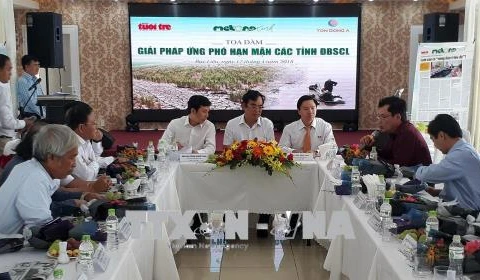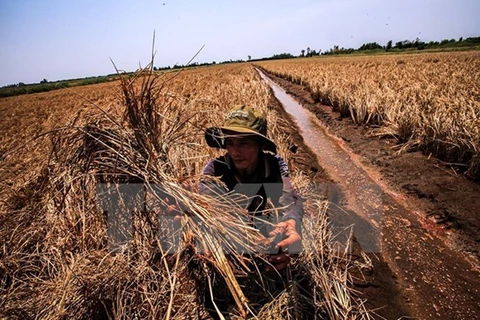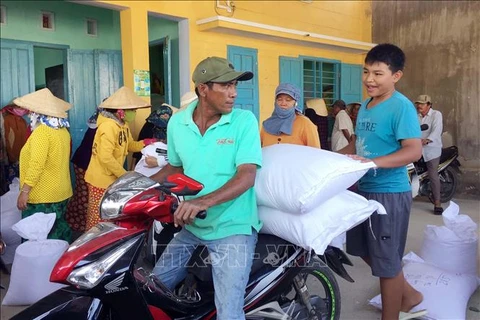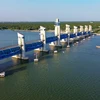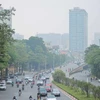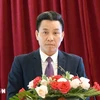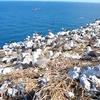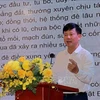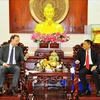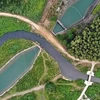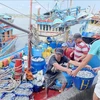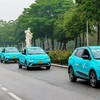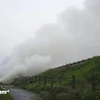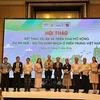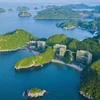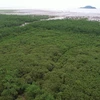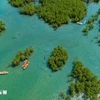 Sheep feed on grass on a parched patch of land in Ninh Thuan province as drought rages in the south central locality. (Photo: VNA)
Sheep feed on grass on a parched patch of land in Ninh Thuan province as drought rages in the south central locality. (Photo: VNA) Quang Nam (VNS/VNA) - This time last year, many parts of the central region were submerged under floodwater, but this year’s unusual aridity in the middle of the rainy season offers little solace.
Hydropower reservoirs stationed upstream of the network of rivers crisscrossing the region are barely scraping by as water levels drop to near the operational minimum, while in downstream areas, locals are struggling to stave off aggressive salt intrusion.
“For the past three months, there has not been one noteworthy spell of rain,” said Briu Liec, Secretary of the Party Committee of Tay Giang, a mountainous district in the south-central province of Quang Nam near the country’s border with Laos.
Liec told Tuoi tre (Youth) newspaper that he has not seen these strange weather conditions in years, as heavy rainfall usually arrives in this district as early as August.
According to Ngo Xuan The, Deputy Director of A Vuong hydropower plant on the A Vuong-Bung river in Tay Giang, 2018 witnessed the worst drought in the last four decades.
The decision to build the hydropower plant at this precise location was made based on the hydrological records of the A Vuong river basin since 1977, but “never before has the water shortage been as serious and in the middle of the rainy season, no less,” The said.
Towards the end of August, the plant began discharging water from its reservoir, expecting an influx in the rainy season that was just around the corner, but as September came and then October, downpours were conspicuous in their absence.
Similarly, Dak Mi hydropower plant in Phuoc Son district is operating at below the minimum water level of 240m, while last year, the level reached 258m, crippling its electricity generation activities and disrupting its schedule to discharge water from the reservoir for downstream use.
Song Tranh 2 plant on the Thu Bon River of Quang Nam is currently running a few hours a day, way below its designed capacity as water levels dropped to 150m, down by 15-22m compared to the same period last year.
The upstream hydropower plants have issued notices to Quang Nam and Da Nang authorities, telling them to have “a reasonable plan of water use” as the forecasted shortage is not letting up anytime soon.
Meanwhile, downstream, local people are reeling from the water shortage as hydropower plants are hogging all the water upstream.
Citizens of the central coastal city of Da Nang complained that the tap water has been running dry as salt intrusion drives a wrench into the operation of the Cau Do water factory.
Da Nang authorities said that on October 29, the salt level of the water body where the Cau Do factory draws its supply from reached as high as 1,082mg/l, while the permitted standard for tap water hovers around 250mg/l.
Dropping water levels also renders the pumps inoperable, exacerbating the thirst.
The Da Nang People’s Committee has been asking the Ministry of Environment and Natural Resources to order water releases from the hydropower plants’ reservoirs in the upstream areas, so as to keep the water level at the An Trach dam on Yen River running through Da Nang city at a minimum of 1.4m to ensure uninterrupted operation of the Cau Do factory.
Hoang Thanh Hoa, Deputy Director of Da Nang’s agriculture department said that only a third of Dong Nghe reservoir’s designed capacity of 17 million cu.m – the largest in the city – is filled. The same is happening to 20 other lakes of various sizes across the city, he said.
As water levels across all streams in the province are falling sharply, Quang Nam’s 39,000ha of rice and 13,000ha of crops run the risk of lower output as the pressure of salt intrusion mounts.
“Without rain or floodwater and the nutrient-rich alluvium they bring, the winter-spring crop season would be seriously affected, not to mention pests and rodents would thrive,” Nguyen The Hung, Vice Chairman of the Hoi An People’s Committee.
Le Thanh Hai, Deputy Director of the National Centre for Hydro-Meteorological Forecasting, attributed the current shortage to a deficit of rain and storms.
On average, each year there should be 10-12 typhoons hitting the East Sea, with about half of them making landfall in Vietnam, however, with just nearly 2 months till the end of the year, there have been only seven storms so far.
“Tropical storms are destructive forces that can cause serious devastation. That’s why every time a typhoon weakens before hitting the coastline it is considered lucky,” Hai said.
“With that being said, as much as 40 percent of the rainfall in the country is brought about by storms or tropical depressions. Storms not making landfall, therefore, means we lose out on a significant source of water.”
According to data, in September and October, the two peak months of the central region’s rainy season, the combined rainfall reached just 50-70 percent of the multi-year average figure, with the forecast for the last two remaining months of the year not any more hopeful.
In addition, it’s predicted with 60-70 percent certainty that El Niño is making a comeback to Vietnam at the end of 2018 and early 2019, engulfing the otherwise flood-prone central region in a long drought with little reprieve in the months to come.-VNS/VNA
VNA

